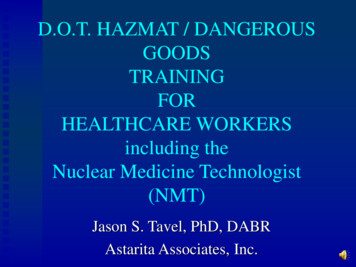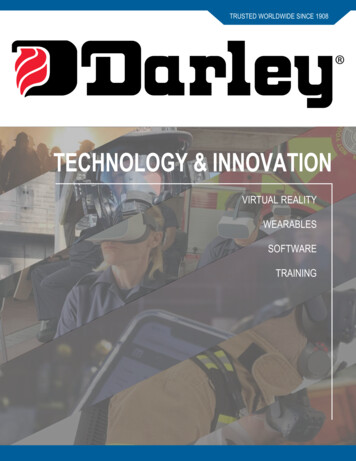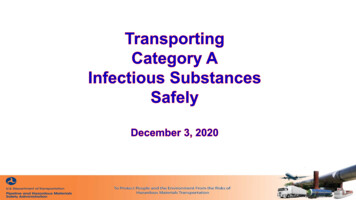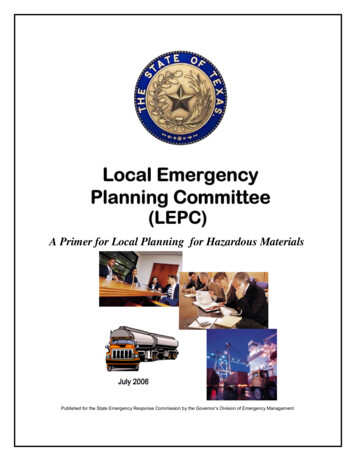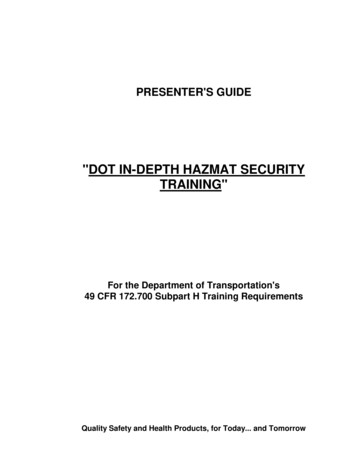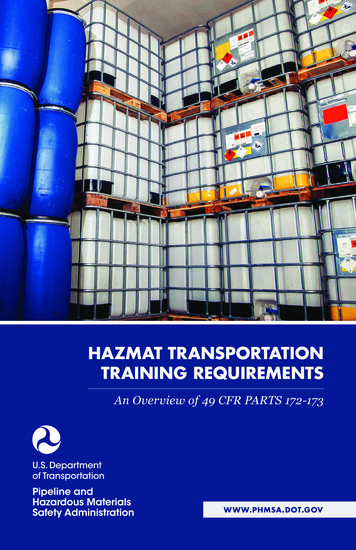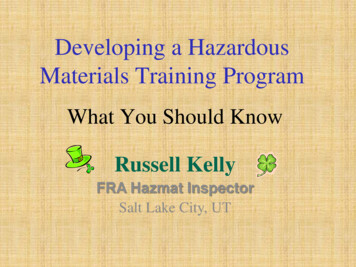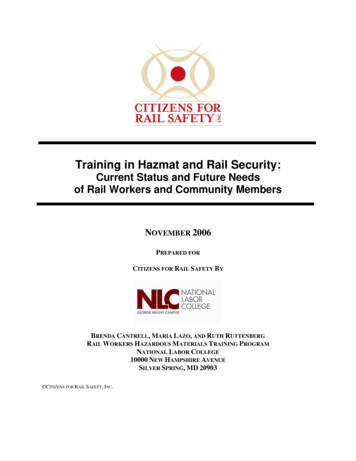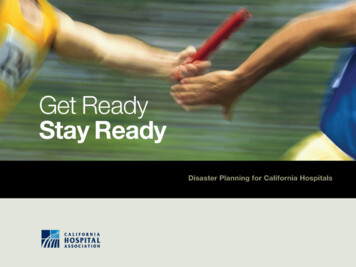
Transcription
Enhancing HospitalHazMat TrainingKristina Freas, MS, BSN, EMT-P, CEMDirector, Emergency ManagementDignity HealthWilliam WennholdEmergency Preparedness CoordinatorMark Twain Medical Center
Objectives1. Review issues that promoted focus on hospital HazMattraining programs.2. Discuss approaches to hospital HazMat training with focus onemployee participation and program sustainability.3. Review online and classroom training approaches developedfor initial and annual training requirements.4. Review program documents to facilitate employee educationand incident response objectives.5. Review implementation strategy and access to resources.5
Dignity Health 380 Care Centers– Hospitals– Urgent & occupational care– Imaging centers– Home health– Primary care clinics 20 States 55,000 employees 9,000 physicians6
Program Assessment Findings Program content and timeframes:– Training programs utilized throughout the organization varied– FRA – 2 – 8 hours– FRO – 8 – 16 hours Compliance:– Drill frequency (never, quarterly, bi-annually, annually)– Equipment upkeep and maintenance– Departments involved with spill and patient decontamination response Competencies:– Inconsistent documentation (completed and on file)– Employee time on task and availability– Just In Time training inconsistent or nonexistent7
Program Assessment — Challenges Regulatory agencies detail-oriented. Available programs did not focus primarily on health care. The need to develop consistent educational approaches andreduce the time on task to reach a wider audience. Reduce Operations class time from 16 hours to 8 hours. Comply with regulatory standards (Fed OSHA and CCR).8
The Need for Change Develop a standard for the organization. Develop self sustaining Awareness and Operations trainingprograms. Promote leadership support. Engage high-risk areas.Time for a Workgroup 9
WorkgroupWorkgroup Members: Jim Majewski – Corporate Director of Security Kristina Freas – Corporate Director of Emergency Management Kathy Dollarhide – EM Coordinator St. Mary’s Hospital Long Beach William Wennhold – EM Coordinator Mark Twain Hospital Susan Shamban – EM Coordinator & Employee Health, NorthridgeHospital Patrick Gibney – EM Coordinator & Security Manager, DominicanHospitalRepresentatives from large and small hospitals participated in planning discussions.10
Workgroup Objectives1.Identify regulatory standards in gap analysis format.2.Evaluate current Awareness/Operations programs utilized within DignityHealth.3.Identify regulations that differentiate the training needs of healthcareproviders versus emergency responders.4.Identify departments to be trained to a Awareness level based on risk ofexposure.5.Identify departments to be trained to a Operations level based on risk ofexposure.6.Recommend annual competency requirements for Awareness andOperations programs.7.Recommend language to support adding CBRNE respiratory protectionstandards to current hospital respiratory protection programs.11
Job TitleANSED RNED Non ClinicalEM CoordinatorSafety OfficerEngineersEVS onExposureRiskLevel of PPERequiredTraining LevelTraining TimeAnnualCompetencyXXXXXX1333333Level DLevel CLevel CLevel CLevel CLevel CLevel OperationsOperations 2 hours8 hours8 hours8 hours8 hours8 hours8 hoursYESYESYESYESYESYESYES8 hours plus24 hours of ICtrainingIncidentCommanderXOversight3Level COperationsICLab EmployeesX**2Level DAwareness 2 hoursYESPathology StaffPharmacy StaffPt. RegistrationRadiology StaffRespiratoryTherapyXXXXX**********22121Level DLevel DLevel DLevel DLevel DAwarenessAwarenessAwarenessAwarenessAwareness 2 hours 2 hours 2 hours 2 hours 2 hoursYESYESYESYESYESSecurityXX3Level COperations8 hoursYESYESExposure Risk1 – Low risk (not directly involved with spill cleanup or patient decon)2 – Incidental spill cleanup (known chemical, proper PPE)3 – Patient decontamination procedures** If employee is a member of a response team h/she is to trained at a n Operations level12
HazMat Awareness Level Training13
Program Development — AwarenessConsiderations:Implementation: Target audience diversity Interactive course developed Consistent training program Technical expertise to develop anonline module570 employees completed thebeta online module Based on feedback changes tothe module were made toinclude expanding scenarios Placed on Health Stream foremployee scheduling and access Develop course content withsubject matter experts Applicability to health caresettings to include clinics Recognize facility diversity Considerations to includecomputer accessibility andcapability14
Awareness Module Demo15
Awareness ModuleMoving Forward: Launch Awareness module accessible to all Dignity Healthhospitals and clinics. Revise module as necessary. Promote leadership talking points and education to assist withimplementation and compliance. Promote and expand departmental educational mandates formodule completion as an annual training requirement.16
HazMat Operations Level Training17
Program Development — OperationsConsiderations: Target audience diversity Consistent training program Implementation: Eight-hour course developed plussupporting materialsOperations course to build uponawareness course objectives Curriculum reviewed by subjectmatter experts Eight hours of didactic training Two beta classes completed Facility-specific equipmentorientation to be accomplished as asecond training date or drill Based on feedback, changes made tocurriculum and course materials Train the trainer classes Instructor website developed toaccess resources and coursematerials18
Implementation Strategy Operations train the trainer program developed. Engaged community agencies to participate in review andtraining curriculum. Developed a Share Point for access to program documents andresources. This provides a one stop shop for all updated coursematerials. Classes scheduled in multiple service areas. Email address provided to employees to facilitatecommunication and program feedback. Obtained updated inventory assessments from Dignity Healthhospitals.19
Program Development — Inventory Assessment Based in hospital assessments, decon equipment was found tobe in varying levels of readiness. Issues identified included:– Equipment degradation– Disorganization– Inaccurate inventories– Training equipment mixed with equipment for deployment– Expired equipment: Powered Air Purifying Filters (PAPR filters)– Incomplete communication capabilities (bullhorn, radios & microphones)– Lack of strategy for deployment (rolling carts, totes, etc.)– Incomplete inventories to support decon operations (white boards, sharpiemarkers, trauma scissors, sponges/brushes, buckets, resource materials, etc.)20
Operations Course Materials Participant Guide Hospital HazMat Operations Level Training Presentation Acronyms and Abbreviations List Chemical Risk Assessment Worksheet Suite Time Log Donning/Doffing Competency Decontamination Overview Emergency Hand SignalsLeadership Resources: ICS Forms and Planning P Awareness course talking points Job Action Sheets (JAS) Operations course talking points Post-Test Course flyers/handouts Class Evaluation Listing of high risk departments Patient decon plan examplesAll class materials are available on theHazMat Share Point
Patient Decon Drill With Ventura County EMS22
Patient Decon Drill WithVentura County EMS (cont.)23
Patient Decon Drill WithVentura County EMS (cont.)Morning Drill24
Patient Decon Drill WithVentura County EMS (cont.)Afternoon Drill25
Patient Decon Drill WithVentura County EMS (cont.)26
Operations ProgramCurrent State: TtT Program 35 instructors Classes 7 classes/102 employees Implementation 15 hospitalsMoving Forward: Promote the sustainability of the programs with leadership support. Assist with program evaluation and equipment/resource deployment strategies. Continue to evolve Operations training program. Continue to improve upon programs based on lessons learned and best practicemodules. Provide program and resources to health systems for evaluation.27
Special ThanksSpecial thanks to:Dan Wall, RN – Ventura County EMSErik Hansen – Ventura County EMSErik Angle, RN – Sutter Roseville Medical Center
Thank youKristina FreasKristina.Freas@DignityHealth.orgWilliam WennholdWilliam.Wennhold@DingityHealth.org29
Questions?
HazMat Training . 5 1. Review issues that promoted focus on hospital HazMat training programs. 2. Discuss approaches to hospital HazMat training with focus on . Awareness 2 hours : YES . Security . X . X : 3 . Level C : Operations . 8 hours : YES . Exposure Risk 1 - Low risk (not directly involved with spill cleanup or patient decon)
